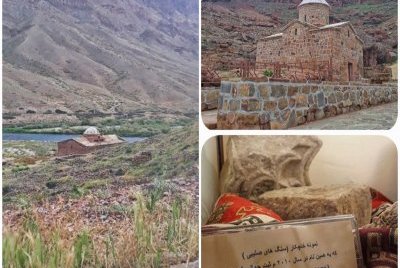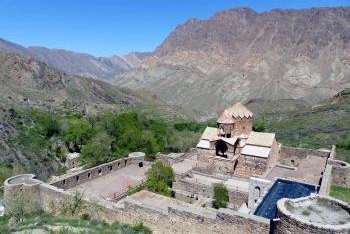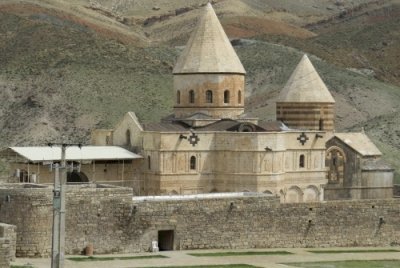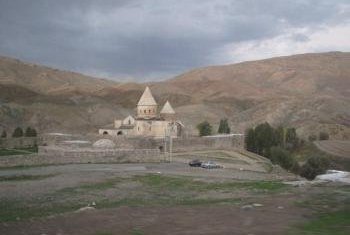Iran
Armenian Monastic Ensembles
The Armenian Monastic Ensembles of Iran bear testimony to the spread of Armenian culture and Armenian architectural and decorative traditions.
The three religious sites originate from between the 7th and 14th centuries but have been rebuilt many times due to natural and human-inflicted disasters. The monastery of St. Thaddeus is the second religious centre for the Armenian church, as the supposed place of the tomb of St. Thaddeus, one of the twelve Apostles; it is a place for yearly pilgrimage.
Community Perspective: Els visited Saint Thaddeus Monastery, while Solivagant also added his perspective on the Monastery of St Stepanos. The Dzordzor chapel so far has stayed unreviewed.
Site Info
Official Information
- Full Name
- The Armenian Monastic Ensembles in Iran (ID: 1262)
- Country
- Iran
- Status
-
Inscribed 2008
Site history
History of Armenian Monastic Ensembles
- 2008: Revision
- Includes former TWHS St.Tatavoos Cathedral (Qara-Kelissa) (1998)
- 2008: Inscribed
- Inscribed
- Type
- Cultural
- Criteria
- ii
- iii
- vi
Links
- UNESCO
- whc.unesco.org
- Official
-
- visitiran.ir — Visit Iran
- Related
-
- unesdoc.unesco.org — Three Armenian jewels in Iran
All Links
UNESCO.org
- whc.unesco.org — whc.unesco.org/
Official Website
- visitiran.ir — Visit Iran
Related Resources
- unesdoc.unesco.org — Three Armenian jewels in Iran
Community Information
- Community Category
- Religious structure: Christian
Travel Information
Red Zone Travel Advisory
Recent Connections
-
Perfect Inscriptions
2008 -
Red Zone Travel Advisory
Iran fully off-limits -
UNESCO Intangible Cultural Heritage Lists
Pilgrimage to the St. Thaddeus Apostle …
Connections of Armenian Monastic Ensembles
- Geography
-
-
Kurdistan
In Iranian Kurdistan (St. Thaddeus) -
On National Border
St Stepanos and Darrasham Chapel reach to the Araxes river, the border between Iran and Azerbaijan
-
- Trivia
-
-
Moved from location of original construction
"The Chapel of Dzordzor is in fact the remains of a much larger monastic ensemble, which disappeared at the start of the 17th century. Its vestiges were moved and reerected because of the construction of a dam. The dismantling of the ruins of the chapel and its reconstruction were carried out in 1987-1988" -
Modelled after
The White Church was added at the start of the 19th century, and seems to have been rebuilt to imitate the patriarchial church of Echmiatsin (present-day Armenia) - AB ev
-
- History
-
-
Silk Roads
(Near) Classic Land Route; in ICOMOS thematic study but no details on role or function
-
- Architecture
-
-
Conical roofs
-
Muqarnas
St Stepanos: a rather nice Muqarna above the entrance
-
- Damaged
-
-
Destroyed or damaged by Earthquake
St. Thaddeus was destroyed at around this time by an earthquake (1319).(AB ev)
-
- World Heritage Process
-
-
Extensions on Tentative List
Monastery of St. Amenaprkich (New Julfa Vank) (01/02/2019) -
Perfect Inscriptions
2008
-
- Religion and Belief
-
-
12 Apostles
Supposed tomb of St Thaddeus -
Christian Churches in non Christian countries
(Iran <2%. Elsewhere stated as .4%) -
Christian Pilgrimage Sites
-
Tombs of Biblical Figures
Supposed tomb of St Thaddeus -
Armenian Orthodox Church
"Saint-Thaddeus, the presumed location of the tomb of the apostle of Jesus Christ, St. Thaddeus, has always been a place of high spiritual value for Christians and other inhabitants in the region. It is still today a living place of pilgrimage for the Armenian Church." (OUV)
-
- Constructions
-
-
Cemeteries
Several cemeteries are included, including 2 within the St. Thaddeus ensemble (AB ev)
-
- WHS on Other Lists
-
-
UNESCO Intangible Cultural Heritage Lists
Pilgrimage to the St. Thaddeus Apostle Monastery (2020, Iran + Armenia)See ich.unesco.org
-
- Timeline
-
-
Built in the 7th century
Records on St. Thaddeus and St. Stepanos (649)
-
- Visiting conditions
-
-
Red Zone Travel Advisory
Iran fully off-limits
-
News
No news.
Recent Visitors
Visitors of Armenian Monastic Ensembles
- Afshin Iranpour
- Alexander Barabanov
- Alexander Lehmann
- Alexander Parsons
- Ammon Watkins
- Atila Ege
- BaziFettehenne
- Bernard Joseph Esposo Guerrero
- Bram de Bruin
- Can SARICA
- Christian Wagner
- David Marton
- Els Slots
- Erik Jelinek
- Fan Yibo
- Harry Mitsidis
- henryjiao18
- Ivan Rucek
- Janos
- Jean Lecaillon
- Jonas Kremer
- Knut
- Maciej Gil
- Martina Rúčková
- Miloš Tašković
- Nihal Ege
- Roman Bruehwiler
- Solivagant
- Szucs Tamas
- Thomas Buechler
- Timothy C Easton
- Wojciech Fedoruk
- Zizmondka
- Zoë Sheng
Community Reviews
Show full reviews
There seems to be a shared frustration about Dzordzor in the group. I also did not get to see it during my visit. As previous reviewers have already tackled a great deal about St. Stephanos and St. Thaddeus monasteries, I'd like to focus on Chupan Chapel, which is conveniently located on the way to St. Stephanos from Jolfa, and Darrasham Chapel (AKA Church of the Holy Mother of God), both components of the St. Stephanos Monastic Ensemble. After visiting the monastery, the driver of the rented car took it upon himself to drive us further to check Darrasham Chapel, of which Solivagant was right when he said that it lies in the "no photography zone". Apparently locals can go near the structure and some, as suggested by a few rubbish, even use the area for picnics. Among the three components of the ensemble, this chapel boasts the best setting in my opinion: deep in the valley, directly along the river (where one literally stares at the border fence), and surrounded by flowers (in the right season). One can rightly liken it to be from an idyllic countryside painting. Darrasham Chapel is supposed to be a village chapel, but there is hardly any sign of habitation in sight. Lying around the chapel are rubble, and it is hard to tell if they were from any previous significant structures. There seems to be little information about them. The structure is not in the best condition, in fact one may call …
Keep reading 0 comments
As Els has recently reviewed the St Thaddeus Church part of this WHS, I will concentrate on its second “ensemble” (the word used by UNESCO) - around St Stepanos Monastery. This lies around 15kms west of the town of Jolfa, which is itself c230kms (a 2.5 hour drive by car) north of Tabriz on the Iran-Azerbaijan frontier opposite its Azerbaijani counterpart of Julfa which is situated within the exclave of the Nakchivan Autonomous Republic.
In order to place St Stepanos in its geographic and historical context, it is perhaps worth dwelling a little on the history of nearby Julfa/Jolfa in relation to Armenia. Julfa developed in the late middle ages into a prosperous, entirely Armenian, town and was captured from the Ottomans in 1603 by Shah Abbas. He decided he couldn’t hold it and decided forcibly to evacuate its inhabitants to use their skills in helping to build/populate Isfahan! Today there is a prosperous suburb of Isfahan called “New Jolfa" which contains the highly ornamented (and recommended) Vank cathedral built by those resettled Armenians from 1606. The remains of Old Julfa became an archaeological site which included a cemetery containing many fine Khachkars. (Armenian carved tomb stones) – none of which now remain. Azerbaijan says that there never were any and Armenia that Azerbaijan destroyed them all between 1998 -2006! “Facts” would seem to support Armenia in this particular aspect of the Armenian-Azeri spat.
The road from Jolfa to St Stepanos and on to St Thaddeus runs alongside the Iran-Azerbaijan …
Keep reading 0 comments
The Armenian monastic ensembles comprise two monasteries and a church belonging to the Armenian Apostolic Church of Iran. This was probably the WHS I was most looking forward to in preparation of my recent tour of Azerbaijan & Northern Iran. Since it has been added to the List, I’ve always wondered why a Shiite theocracy would nominate a purely Christian pilgrimage site. Also, remote monasteries belong to my favourite types of WHS.
Out of the inscribed locations, I only visited the St. Thaddeus monastery, which is considered the main site. Legend has it that the apostle St. Thaddeus brought Christianity to Armenia, and this spot (now located on Iranian soil) was the place where he died. Sometime between the 7th and 10th centuries, the St. Thaddeus Monastery was founded here. It developed into a place of pilgrimage for Armenians from Iran and neighbouring countries. Annually in summer, a big festival is held in the vicinity of the monastery, with thousands of pilgrims staying in tents. From 1930 to 1947, the monastery was the seat of the Catholicos (spiritual leader) of the Armenian church.
As befits any good monastery, it lies in a very remote spot. The day before my visit I overhead our Iranian guide and Dutch tour leader in a fierce debate about how far the drive from Tabriz is and whether it is worthwhile to make a day trip. Neither of them had ever been there or possessed reliable information about the distance and road conditions. …
Keep reading 0 comments
It is a serial nomination, but consists only of two elements, the St Stephanos monastery near Jolfa, and the "Black Church" (or, officially St Thaddeus monastery) near Maku. It is possible to do both on one day, but it will be a long and exhausting journey. Though theoretically one can get an Iranian tourist visa without having a local agency to fix his travel arrangements, it is advisable to have one, specially if you want to visit off the beaten track destinations - like these monasteries - as public transport will not take you there. Prior arrangements are helpful financially also, as - due to the sanctions still in function - no credit cards work in Iran, and bank transfers are also quite difficult. We made the arrangements through an Iranian friend, who hired a vintage Mercedes bus for us - the best option available in Tabriz. As our maximum speed on highways was cca 40 km/h, long journeys looked even longer.
St Stephanos is much easier to reach - but far less interesting than the Black Church. It is close to Jolfa, a bustling border town, that connects the Islamic Republic both with Armenia and with Azerbaijan. Jolfa is an easy two-three hours trip from Tabriz, the capital of the province, and the place most probably you will spend the night. From Jolfa the road winds near river Arax, the border with Armenia. The natural setting of the monatery is really stunning - on a lush green slope, looking …
Keep reading 0 comments

